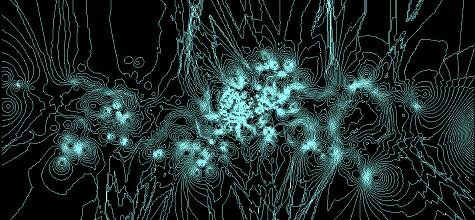Wed 14 Sep 2005

City-Medium-City. Kunsthaus Graz
Oct 01, 2005 – Jan 08, 2006
(Visual analysis of Graz)
SENSEable City Lab, MIT Carlo Ratti (coordinator), Daniel Berry, Andrea Mattiello Eugenio Morello, Andres Sevtsuk Design team: David Lee, Xiongjiu Liao, Jia Lou, Sonya Y Huang, Daniel A Gutierrez In collaboration with A1 – Mobilkom Austria writes:
> The city demands continuous interpretation
Today the experience, infrastructure and morphology of the city are more closely related than ever before. The profusion of handheld electronic devices with increasingly powerful networking capabilities offers its users new modes of interaction within the urban environment. It also provides designers, artists, and theoreticians a new means for engaging and understanding the city. Therefore, forget old ways to describe cities!
> Real-Time Graz
Digital Derive harnesses the potential of mobile phones as an affordable, ready-made and ubiquitous medium that allows the city to be sensed and displayed in real-time as a complex, pulsating entity. Because it is possible to simultaneously ‘ping’ the cell phones of thousands of users – thereby establishing their precise location in space at a given moment in time – these devices can be used as a highly dynamic tracking tool that describes how the city is used and transformed by its citizens. The polis is thus interpreted as a shifting entity formed by webs of human interactions in space-time, rather than simply as a fixed, physical environment. Digital Derive provides a platform upon which the contemporary city can register the flux and traces its self-constructing and open-ended nature. Previous initiatives, notably Laura Kurgan’s ‘You Are Here: Museu’ (1996) and the Waag Society’s ‘Amsterdam Real-Time’ (2002) initiated this process by exploring the qualities and potential of GPS technology. Digital Derive builds on an expands these efforts by using cell phone technology, for the first time, to radically increase the interactive capacity and number of users involved in the mapping of the city. Digital Derive (re)presents the city displayed simultaneously in the Kunsthaus Graz and in a publicly accessible website.
> Real-Time Tracking
The Real-Time City Map will register and visually render the volume and geographic source of cell phone usage in Graz, thus showing a different layer in the use and experience of the city. Furthermore the users of A1 Mobilkom Austria in Graz will be tracked anonymously by ‘pinging’ their cell phones as they move through the city. The record of this movement will be collected, processed and finally displayed as set of dynamic traces showing their paths through the city on the same map. However, visitors at the exhibition will have the opportunity, if they wish, to register while buying their tickets. Their traces will then be highlighted on the overall background on the general map together with their profiles and names – as nervous terminations that stopped at the exhibition and then moved into the city.
> means
The digital maps can now be experienced in real-time as they constantly transform and shift in status. The project is thus a means of observing, and reading the city, a tool that traces its evolution and fluctuation. Finally, by harnessing cell phones as devices that can track/monitor its users Digital Derive also raises questions about the relationship between information and communication technologies (ICTs) and the contemporary city. How does technology shape the way in which we describe and represent the contemporary urban condition? What effects and possibilities does this technology generate as a tool of analytical inquiry? What are the new forms and interpretations that mapping can adopt today, and how can citizens actively respond and participate in the process of mapping their surrounding environment? How does this technology respond to issues of control, freedom, hegemony, privacy and geo-slavery?